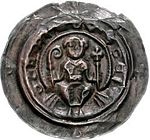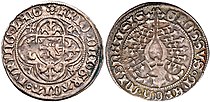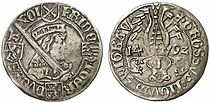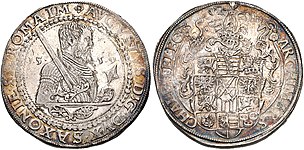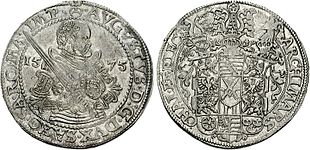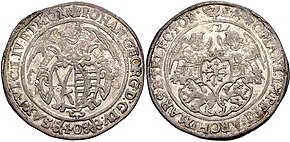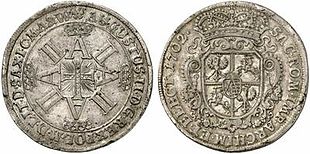Saxon coin history
The Saxon coin history or also Meißnisch-Saxon coin history comprises three major periods: the high medieval regional pfennig period ( bracteatic period ), the late medieval groschen period and the thaler period up to the introduction of the mark currency in 1871/72. Rich silver deposits, which were discovered near Freiberg as early as the middle of the 12th century, gave Saxony a leading position in German coinage.
The Saxon pennies minted in eastern Saxony are also mentioned, as is also the case in Walther Haupt's Sächsischer Münzkunde. They were minted on the basis of the Carolingian coin reform , on which the oldest Meißnian coinage is based. The different coin names of these types of penny point to an as yet unexplained position within medieval numismatics .
Hochrandpfennig (Sachsenpfennig)
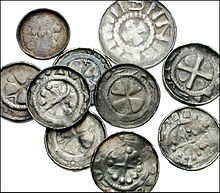
The pfennig type known as Sachsenpfennig with upset edge from the 10th and 11th centuries is the most common pfennig type of this time , along with the Otto Adelheid pfennig . Sachsenpfennige are the oldest coins minted in Saxony . The pennies of the Saxon imperial period with the inscription OTTO or ODDO in the portal of a church were probably struck under Otto I (936–973) or soon after in Magdeburg and are among the oldest group of pennies in the Saxon high- rim pfennigs .
The Margraves of Meissen still minted as ministerials on behalf of the Roman-German Empire . Margrave Ekkehard I of Meißen (985-1002) had pennies struck in the Meißen Imperial Mint . The denarius with the inscription EKKINHARD and MISSNI is the oldest known Meissnian coin.
Expiry of the penny coinage
The conversion of the weight pound into a counting pound during the reign of the Frankish Emperor Henry IV (1056–1106) resulted in the forfeiture of the pennies minted on both sides. The weight pound of 367 g was converted into a counting pound of 240 pfennigs, the weight of which decreased continuously. The lighter pennies were enlarged in diameter. The sheet to be minted was finally so thin that it could no longer be embossed in one operation with the lower and upper punch at the same time. When embossing the so-called thin pennies , the blank therefore had to be turned over to emboss the opposite side. The stamp pressure on one side damaged the coin image on the other side. In order to achieve a good coin image, it made sense to forego the second punch and also to save the second working step.
This phenomenon probably led to the coinage of the bracteates beginning around 1140 under the margrave Conrad the Great (1123–1156).
Bracteatic time
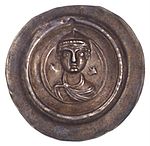
Most of the Meissen bracteates were provided by the first Meissen mint , the Freiberg Mint , between 1170 and 1300 . It had been the main state mint of the Wettins since the 13th century . In addition to pennies, halves and quarters were also given out. Large payments were made in bar silver .
The bracteates of all Meißnian and Upper Lusatian mints were struck according to a uniform minting style and coinage rate . The Freiberg mint master was instructed not to strike more than 244 or 246 pfennigs from the (Prague) mark silver weighing 253 g. That corresponds to an average weight of a penny of a good 1 g. The highest average weight in the Puschwitz bracteate find from the early minting around 1140 was only 0.811 g. At the end of the 13th and beginning of the 14th centuries, the average weight was 0.573 g.
The pennies were only valid in the area of origin. The bracteatic period is therefore also referred to as the period of the regional penny. Who came from another area to trade that brought had currency in indigenous changing over. The change was one of the income of the mint master .
The cost of minting coins had to be covered by an annual fee-based exchange of the pennies, twelve old ones for nine or ten new ones. In Freiberg city law it was determined that only the mint master or judge himself could devalue (break) the expired pennies. The fragile pennies were carried in tin cans.
See also :
- Eternal penny
- Bautzen Mint, Bracteate Period
- Colditz Mint, Bracteatic Period
- Freiberg Mint, Bracteatic Period
- Gotha Mint, Bracteatic Period
- Langensalza Mint, Bracteatic Period
- Mint Leipzig, first evidence (with bracteates)
- Weimar Mint, Bracteatic Period
- Wittenberg Mint, Bracteate Period
Dynasty bracteates

Numerous independent dynasts in the Wettin areas were in possession of the imperial shelf , the right to mint . Tested are: (table according to Haupt)
|
See also :
The increasing power of the Meissen margraves in the 14th century led, with a few exceptions, to the end of the minting of imperial ministerials .
Spiritual bracteates
The bishops of Naumburg had exercised the right to mint in Strehla on the Elbe in association with the Margrave of Meissen.
The bishops of Meissen also appeared as mountain lords and minters and had bracteates minted. At the end of the 12th century mines were built in Scharfenberg on the Elbe . Later the two episcopal castles Wurzen and Stolpen come into question as possible minting locations . The last Meissen bishop's tracts were struck towards the end of the 13th century.
As an abbey entitled to coinage , the Pegau Monastery in Pegau also minted bracteates, which have a large crutch cross and usually a name as a distinctive mark . Because of their consistent and good silver, they were popular and were even minted. Copies of the Burgraves of Meißen , the bailiffs of the Pegau Abbey, the Margrave Dietrich , the Counts of Brehna and the Archbishops of Magdeburg are known .
Age classification of the Meissen bracteates
Konrad the Great (1123–1156), oldest Meissen type
Henry the Illustrious (1221–1288), minted around 1250
The chronology of the Meissen bracteates is difficult. Except in the early days, the names of the minters only appear on the pennies in exceptional cases. The rough classification was made according to Walther Haupt, pp. 34/38.
| Period | Dimension / feature | comment |
|---|---|---|
| around 1140/1150 | Diameter up to 37 mm, flat embossing | The oldest bracteates were stamped with forged steel stamps. The die cuts are evidence of Romanesque cabaret . The design of the coin extends to the edge. |
| after 1150 to the end of the 12th century | Gradual reduction of the diameter down to 20 mm | The coin weight hardly decreased. The bracteates were thicker and therefore more resistant to breakage and pressure. A wide and high bead ring that surrounds the coin image increased the bending strength. |
| around 1200 to around 1250 | Diameter up to 40 mm, larger profile | The die made of cast bronze saved the die cut. The casting technique required larger profiles and larger diameters. As before, the bracteates have a stiffening ring, the “prince enthroned” became a typical coin image. |
| from about 1250 to 1300 | "Greedy" surface, large diameter | Bracteates were mass-produced due to the high silver yield of the pits. The slightly rough surface of the stamp made of cast bronze was no longer smoothed. |
| around 1300 | bulged almost to the shape of a hat | Several planes placed one on top of the other were formed in one embossing process . The coin design merges into the edge. |
For the export trade, the regional pfennig was a major obstacle with its restricted area of application and its annual exchange requirement. Uniform money that applied to larger areas was required. Larger coins were needed, not just pennies.
The regional penny period ended under Margrave Friedrich II (1323–1349).
Dime
After the penny currency was replaced by the large groschen (grossi lati) introduced by Margrave Friedrich II in 1338/39 , the late medieval groschen period began. The new penny was in the Freiberg coin modeled after the year 1300 in Bohemia coined Prague groschen coined. When converting the currency in the Margraviate of Meissen , as in the Kingdom of Bohemia, Italian financial advisors were consulted.
The currency adjustment to the new, lighter Rhenish guilder as the basis for the Meissnian groschen currency took place in sections from 1368 to 1369. Besides dimes and pennies and were Heller coined. The groschen was worth 9 or 12 pfennigs, the pfennig 2 hellers. The Meissen groschen became the leading monetary unit in Central Europe alongside the Prague groschen .
At the end of the 14th and 15th centuries, in addition to their main mint in Freiberg , the Wettins established other mints in Sangerhausen , Zwickau , Gotha , Leipzig , Weimar , Colditz , Wittenberg and Langensalza , some of which were only in operation temporarily. The Freiberg Mint remained the state's main mint until it was closed.
The Colditz mint was owned by Electress Margaretha , wife of Elector Frederick II (1428–1464). An extraordinary event in the history of coins in Saxony is the fact that the elector erected a coin in Colditz in 1456 for his wife as compensation for the high treasure she was entitled to and allowed her to have her own coins minted there. The so-called Margarethenroschen with an additional "M" in the legend attest to this coinage.
As a result of the high spending policy of Margrave Wilhelm I the One-Eyed (1382-1407), the land and population were heavily burdened.
The foreign cities countered the increasing deterioration in coins by counterstamping the still good Meissnian groschen. It was not until 1412 that Frederick the Arguable (1381-1428) succeeded in stabilizing the groschen currency on the basis of 20 shield groschen on the Rhenish guilder.
Saxony had to recognize the Rhenish gold guilder for the payment obligations of long-distance trade . From 1456 it was finally minted in the large trading metropolis of Leipzig (see Leipzig Mint ).
The discovery of new, rich silver deposits in the upper Ore Mountains near Schneeberg and Annaberg led to another mining period in Saxony in the second half of the 15th century. The newly built "Bergmünzstätten" Schneeberg , Zwickau (where the minting operation had been shut down since 1449), Annaberg and Buchholz had to cover the increasing payment obligations with extensive coinage.
The Meissnian guilder , which was used as an invoice coin until the 19th century, goes back to the Saxon coinage system of August 9, 1490, according to which the gold guilder in Saxony was set at 21 groschen.
See also:
Special Meissnian-Saxon groschen
Margrave Friedrich the Arguable , Freiberg Helmgroschen 1405–1411
Elector Ernst, Duke Albrecht, Duke Wilhelm III, horn groschen from 1466, Leipzig mint
Elector Ernst, Duke Albrecht, Duke Wilhelm III. with Electress Margaretha (1475–1482), pointed groschen 1475, Colditz Mint ( Margarethengroschen )
Elector Friedrich III., Johann and Duke Georg, beard groschen from 1492, Zwickau and Schneeberg mints
Elector Friedrich III. with Johann and Duke Albrecht, Schneeberger, interest groschen from 1498
- The helmet groschen or Thuringian groschen are good-value groschen minted from 1405 to 1411 under Margrave Friedrich the Arguable of Meißen and Landgrave Balthasar of Thuringia in the Margraviate of Meißen and the Landgraviate of Thuringia , which were mainly intended for the Thuringian possessions. The name of the groschen is derived from the helmet with the large Thuringian crest on the back. The helmet groschen are the first Meissnian groschen that deviate from the typical coin image up to now. With these groschen with the eye-catching coin image, the Wettins wanted to support the currency, which had been weakened by continuous coin deterioration.
- The Judenkopf dime is an elector under Friedrich II. The Meek of Saxony (1428-1464) after the coinage system 1444 embossed to about 1451 Oberwährgroschen . His brother, Duke Wilhelm III , also took part in this project . the brave (1445–1482). The name of the coin is derived from the reverse with the Meißner helmet ornament with the man's head, the so-called Jewish head.
- The Horn dimes were from 1465 to 1469 by the Dukes Ernst and Albrecht with her uncle Wilhelm embossed (1465-1482) as Oberwährgroschen. The penny type is the first that the Wettins had minted with a year after 123 years since the first penny was minted. The weakened Saxon currency was to be replaced by a completely new and stable currency after the efforts to achieve a stable currency through the coin reforms of 1444 and 1456/57 through the creation of a double penny currency in the form of an upper currency and an auxiliary currency had failed.
- The Spitzgroschen were under Elector Ernst (1464 / 85–1486), his brother Duke Albrecht the Courageous (1464 / 85–1500) and their uncle Duke Wilhelm III. the brave (1445–1482) struck from 1475 to 1482 on the basis of the coinage order of December 28, 1474, in order to dispel the population's distrust of the equivalent horn groschen made of alloyed silver. In the Electorate of Saxony under Elector Moritz (1541–1547–1553) and under Elector August (1553–1586), re-coins were made from 1547 to 1553.
- The so-called Margarethengroschen are the Saxon groschen minted from 1456 to 1477 from the Colditz mint with an additional "M" at the beginning or within the romanization. The “M” refers to Margaretha (* around 1416, † 1486), wife of Elector Frederick II (1428–1464) of Saxony. Margaretha appears on coins from 1456 as an illegal mint princess because she put her name letter in front of that of the elector and also had sole mints made, although she only got the right to mint from the emperor in September 1463 .
- Beard groschen is the name of the groschen with the bearded bust of Frederick III, which was minted from 1492 to 1493 in an edition of 205,000 in the Zwickau and Schneeberg mints . (1486-1525). The groschen are the first coins in Saxon coin history with a portrait of the regent.
- Tribute Money , Mutgroschen or Schneeberger are the names of the embossed from 1496 Saxon penny coins, which also certain charges (interest) were paid. This new type of groschen was coined for 3½ decades and was the model for the groschen of the 16th century.
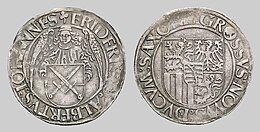
- The Schreckenbergers, made from the silver of the Schreckenberg pits , were minted according to the coin order of August 18, 1498. The new large groschen had a value of 3 groschen and were brought out with a fineness of 861/1000. Seven Schreckenbergers yielded a Rhenish gold gulden.
The interest groschen minted from the Schneeberg silver and the Schreckenberger were used to prepare the new silver guilder currency introduced in 1500 based on the Tyrolean model , the first Saxon taler coins.
See also :
- Freiberg Mint # Groschenzeit
- Colditz Mint # Groschenzeit
- Mint Gotha # Groschenzeit
- Mint Langensalza # Groschenzeit
- Mint Leipzig # Groschenzeit
- Schneeberg Mint # Groschenzeit
- Weimar Mint # Groschenzeit
- Wittenberg Mint # Groschenzeit
- Zwickau Mint # Groschenzeit
Thaler time
From 1500 until joining the Imperial Coin Order in 1571
At the end of the 15th century, new technical and economic methods in Saxon mining resulted in an unusually high silver yield . This led to Elector Friedrich III. the sage (1486–1525) and his brother Johann the Steadfast (1486 / 1525–1532) in agreement with George the Bearded (1500–1539) as deputy of his father Albrecht the Courageous (1464 / 85–1500) the so-called Leipziger Münzordnung von 1500 proclaimed. Then a groschen ( guldengroschen ) for a gulden (Rhenish gold gulden) should be struck and taken. The Taler (so-called Klappmützentaler ), initially called the Gulden and Guldengroschen, was the silver equivalent of the Rhenish gold guilder.
On coins, the Locumtenenstalern of the Elector of Saxony, the dignity of imperial vicar appears for the first time in 1507 in the form of “Imperique locumtenens generalis” (Latin = imperial governor). They are the first vicariate coins from Saxony.
During the time of the Saxon coin separation , the common coinage agreed in the Leipzig main division in 1485 between the Ernestines and Albertines was temporarily suspended from 1530 to the end of 1533. When the Ernestines lost their electoral dignity to the Albertines in 1547 , the previous fraternal coinage was finally ended. The new Elector Moritz (1541–1547–1553) only minted in his own name. A new period began, a separate coin history for the Albertine Kurlinie of the House of Saxony.
The coinage of the Ernestine line and later lines and subsidiary lines in the widely ramified Thuringian lands that remained are also part of Saxon coin history, but their diversity can be treated separately.
Elector August (1553–1586) centralized minting by combining all state coins into a single mint. The new mint in Dresden became the central mint for the entire electorate. With August's accession to the Imperial Coin Order in 1571, the second section of the taler currency began.
- Taler coins according to the Saxon standard:
Elector Friedrich III. and the dukes Johann and Georg, Gulden ( Klappmützentaler ) undated, Mmz. Cross (1512–1523), Annaberg Mint
Elector Moritz, Guldengroschen 1552, Freiberg Mint . Final coin separation since 1547
Elector August, guldengroschen, 1559, Dresden Mint
Elector August, thaler (guldengroschen) 1567, on the capture of Gotha , Dresden mint
Minting according to the Reichsmünzfuß

In 1571, Elector August and the estates of the Upper Saxon and Lower Saxon Imperial Circles joined the Imperial Coin Order. The 10 districts in which the Holy Roman Empire of the German Nation was divided were responsible for monitoring compliance with the Imperial Coin Order.
The expression after joining the Imperial Coin Order in 1571 : (Extract from Arnold)
- Münzfuß 1571–1667 ( Reichsmünzfuß ): 9 Reichstaler on the fine mark
| Nominal | Weight (g) | Fineness (0/00) |
|---|---|---|
| Reichstaler at 24 groschen | 29.23 | 888.89 |
| ½ Reichstaler at 12 groschen | 14.62 | 888.89 |
| ¼ Reichstaler at 6 Groschen | 7.31 | 888.89 |
| ⅛ Reichstaler at 3 groschen | 3.61 | 888.89 |
| 1 ⁄ 24 Reichstaler (Groschen) | 2.15 | 500 |
| Threesome (¼ groschen) | 0.85 | 312.5 |
| Pfennig ( 1 ⁄ 12 Groschen) | 0.34 | 250 |
The golden guilders and double guilders, which continued to be minted after Electoral Saxony joined the imperial coinage system, are not among the Saxon denominations of the imperial coinage system. The Reichsgulden to 21 Groschen (1584) is a distinctive bill coin.
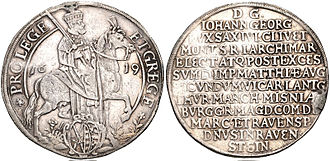
The silver-rich electors of Saxony could afford to produce extensive commemorative coins in addition to currency coins. The Saxon vicariate coins minted from 1612 are commemorative coins of the Electors of Saxony , which they had minted as deputy of the emperor in rich parts under Saxon law during the execution of the imperial throne. They shared the imperial vicariate with the Rhineland Count Palatine . - See also vicariate coins (Palatinate and Bavaria) .
The Upper Saxon Imperial Circle tried between 1571 and 1667 to maintain the imperial coinage rate. The decline in silver mining and the high minting costs of small change and the associated shortage of small change led to tipper and wipper inflation from 1619 to 1623 combined with the establishment of numerous tipper mints .
See also :
Tipper and luffing period (1620–1623)
The monopoly position of the Dresden Mint was broken with the establishment of numerous tipper mints. The great resemblance to the high-quality Schreckenberger or angel groschen minted in Saxony and Thuringia from 1498 to 1571 should make the interim coins popular in Electoral Saxony. The mint could not be objected to, because they were not taler coins or their parts, but groschen pieces, i.e. land coins , which did not have to comply with the imperial coinage system. The smallest coins, i.e. one-sided copper pennies, were produced by the Grünthal copper hammer .
The complete breakdown of the financial system forced Electoral Saxony to return to the Reichsmünzfuß in 1623 . The Reich coinage system was not officially repealed.
See also :
Minted in the Zinnaischen and Leipzig coin feet (1667–1690–1763)
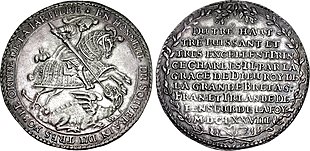
After the end of the Thirty Years' War there was a second or small tipper period, which, however, prevented Kurbrandenburg and Kursachsen by agreeing a coin footer in Zinna in 1667, which took into account the increased silver price. In the same year, the short-term minting of land coins for Upper Lusatia in the specially established Bautzen mint was canceled due to failure. The ⅔ Taler (⅔ Kuranttaler) or Gulden at 16 Groschen became the new main denomination. The Kuranttaler to 24 groschen, previously called Reichstaler, was not issued with a few exceptions. In payment transactions, the thaler was a unit of account at 24 groschen. Therefore the value 24 / EINEN / TALER is stamped on the groschen pieces. The mentioned thaler is the unminted bill thaler. This currency was no longer based on the resolutions of the Reichstag, but on the agreement between the Kurbrandenburg and Electoral Saxony states. The Reichstaler was minted as a Speciesreichstaler at 28 groschen only for the payment obligation of the Saxon mining administration.
The expression after the Treaty of Zinna 1667 : (extract from Arnold)
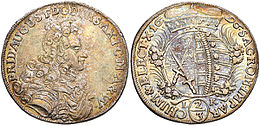

- Zinnaischer Münzfuß 1667–1690: 10½ Kuranttaler on the fine mark
| Nominal | Weight (g) | Fineness (0/00) |
|---|---|---|
| Kuranttaler to 24 groschen | ||
| ⅔ Kuranttaler at 16 groschen | 16.7 | 888.89 |
| ⅓ Kuranttaler at 8 groschen | 9.74 | 760.42 |
| ⅙ Kuranttaler 4 groschen | 4.87 | 760.42 |
| Penny | 1.99 | 465.28 |
| Threesome (¼ groschen) | 0.90 | 250 |
| Pfennig ( 1 ⁄ 12 Groschen) | 0.35 | 204.86 |
The continued rise in the price of silver made it necessary to adjust the currency again in 1690. The result was the Leipziger Münzfuß , which the Regensburg Reichstag declared in 1735 to be the new Münzfuß. The Speciesreichstaler were still minted in the Reichsmünzfuß, but with an increased value of 32 groschen.
- The expression according to the Leipziger Münzfuß (1690–1763) :
- 12 Kuranttaler on the fine mark
The expression according to the Leipziger Münzfuß, that is the Kuranttaler in the denominations as before, were introduced between 1693 and 1733 with different weight and fineness.
The change was minted according to the Torgauer Münzfuß. New denominations were 1 ⁄ 12 Taler (double groschen) and 1 ⁄ 48 Taler (½ Groschen).
- For conversion of the nominal value of the Reichsmünzfußes into the nominal value of the Leipziger Münzfußes see butterfly thaler # Description of the butterfly coins
Embossing in the exchange thaler foot 1670/71

In the years 1670/1671, exchange thalers and their parts were struck in the exchange thaler foot.
The Wechsel taler was brought out under Elector Johann Georg II (1656–1680) in the Wechsel or Burgundian Talerfuß (861/1000 fine ). The taler and its pieces were intended as change to favor Leipzig trade with Hamburg and the Netherlands . The first stamps from 1670 therefore have the inscription WECHSELTHALER on the back. The Wechseleltalerfuß was only valid in Electoral Saxony in 1670 and 1671.
Saxon-Polish bank tellers according to Burgundian feet (1702)
In 1702 , August the Strong (1694–1733) had three different bank notes minted in the Leipzig mint . They corresponded in value to the Polish thalers minted according to the Burgundian foot and were therefore somewhat less valuable than the thalers minted according to the imperial foot. They are lower-value Saxon thalers, but also normal Polish thalers.
The coinage of the bank notes was carried out by the Grand Chancellor Wolf Dietrich Graf von Beichlingen . On the so-called Beichling Ordenstaler , only the cross, but not the Danish Elephant Order, was shown, as was the case with the other two thalers.
Beichlingen was assumed that this cross was that of the Danish Order of Danebro , of which he was a knight, and that the taler was an insult to the king. The count, who was also responsible for the expression of the inferior Red Sighs of 1701 and 1702, fell out of favor. The minting of all three bank notes was stopped in the year of their issue.
Minted in the convention mint foot (1763–1838)
The breakdown of the coinage system during the Seven Years' War (1756–1763) urgently required a coinage reform. The Prussian contributions and the counterfeiting of coins by Frederick II (1740–1786) as a means of financing the war had led to the complete collapse of the monetary system in Saxony and Poland .
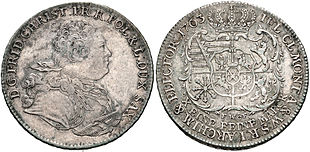
On May 14, 1763, Electoral Saxony and the Ernestine principalities introduced the convention mint , also known as the 20 guilder foot. From the fine silver marrow of approx. 234 g one minted in Saxony:
- 10 convention special thalers = 20 ⅔ thalers = 40 Tal thalers = 80 Tal thalers = 160 1 ⁄ 12 thalers (double groschen) = 320 1 ⁄ 24 thalers (groschen) = 960 1 ⁄ 48 thalers (half groschen).
Calculations were made in convention cure. 1 Taler (Reichstaler) was a unit of account of 24 Groschen. The convention coins from groschen to convention special thaler remained stable in terms of shot and grain during the entire period of validity of the convention mint foot.
The gold coins minted were ducats, 5 thalers (Augustd'or) and 10 thalers (double Augustd'or) , mainly for long-distance and wholesale trade . They also remained unchanged in weight and fineness. Other coins are the heller, pfennig, 3, 4 and 8 pfennig grouped as land coins or coins. Neither the gold coins nor the penny coins were convention money.
From 1804 to 1825, the entire copper coinage for Saxony took place in the Grünthal mint , which was located in the "old hammer" of the Saigerhütte Grünthal and was established as a secondary mint to the Dresden mint.
Minted in the 14 thaler foot (1839–1856)
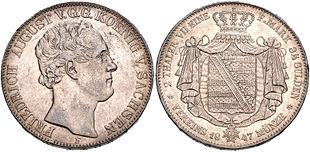
After the introduction of the German Trade and Customs Union, the Customs Union states founded the German Customs Union in Munich and Dresden in 1837/38 , which adopted the Prussian (Graumann) 14 thaler foot . After that, uniform double thalers or 3½ gulden pieces were minted.
In the Kingdom of Saxony, the following was minted from the fine silver mark in 14 thaler feet:
- 7 double thalers = 14 club thalers
- 1 Vereinstaler = 30 new pennies = 300 pfennigs
- 1 new penny = 10 pfennigs (1 fine mark = 420 new penny)
The value of the thaler thus corresponded to the Prussian thaler, the Saxon new penny as 1/30 thaler to the Prussian silver groschen of 1/30 thaler. The Saxon and the Prussian nominal systems differ in the division of the groschen into pfennigs. While Prussia kept the old duodecimal system with the division into 12 pfennings, Saxony took a conscious step towards the decimal system with the division of the groschen into 10 pfennigs. This was particularly evident in the form of 1/3 thaler, which was worth 10 new pennies or 100 Saxon pfennigs.
Minted in the 30 thaler foot (1857–1871) (1872)

In 1857 in Vienna of the accession of Austria and Liechtenstein to the German coinage . The decimal calculation was introduced with the Vienna Coin Treaty. The mark was replaced by the 500 g inch pound and the thaler was issued as a club coin alongside the double thaler . 30 club thalers were minted from the 500 g inch pound. According to this standard, the Dresden mint was minted in Saxony until the introduction of the imperial currency.
The establishment of the Empire without Austria and Liechtenstein made a single currency possible. The German Reich exercised the right to mint coins on behalf of their federal states. With the issuance of the new Mark coins in gold and silver ended the Saxon coinage, although the Saxon kingdom until 1886 in the mint Dresden and then in Muldenhütten in Freiberg until 1953 was a mint in operation. The old 14 thaler foot with the Cologne mark as the basic coin weight , only slightly modified in value by the Vienna Mint Treaty to a 30 thaler foot with the inch pound as the basic coin weight, corresponded to three marks of the new common currency. In the newly introduced mark, the Saxon third thaler lived on for 100 pfennigs. The Saxon pfennigs could thus remain in circulation for many years without any problems at the value of the new pfennigs of the mark.
See also
literature
- Walther Haupt : Saxon coinage. German Science Publishers, Berlin 1974.
- Paul Arnold: Walter Haupt and his "Sächsische Münzkunde". In numismatic notebooks. No. 20, Dresden 1986, ISSN 0323-6919 .
- Paul Arnold, Harald Küthmann, Dirk Steinhilber: Large German coin catalog from 1800 to today. Augsburg 1997.
- Paul Arnold: The Saxon thaler currency from 1500 to 1763. In: Swiss Numismatic Rundschau . Volume 59, 1980, pp. 50-94, doi: 10.5169 / seals-174534 .
- Paul Arnold: The genealogy of the Meissnian-Saxon princes. In: Numismatischer Verein zu Dresden e. V. (Ed.): Dresden numismatic booklets. No. 1/1996, ISSN 1613-3447 .
- Gerhard Krug: The Meissnian-Saxon Groschen 1338-1500. Berlin 1974.
- Lienhard Buck: The coins of the Electorate of Saxony 1763 to 1806. Berlin 1981.
- Arthur Suhle : The coin. From the beginnings to modern European times. Leipzig 1969.
- Tristan Weber: The Saxon coinage from 1500 to 1571. H. Gietl, Regenstauf 2010.
- Claus Keilitz: The Saxon Coins 1500–1547. H. Gietl, Regenstauf 2010.
- Wieland Clauß, Helmut Kahnt: The Saxon-Albertine coins 1611–1694. Regenstauf 2006.
- Julius Erbstein , Albert Erbstein : Discussions in the field of the Saxon coin and medal history when listing the Hofrath Engelhardt's collection. Dresden 1888.
- Rudolf Lorenz: The coins of the Kingdom of Saxony 1806–1871 and the Grand Duchy of Warsaw 1807–1815. Berlin 1968.
- Christian A. Kohl: Tal parts of the Electorate of Saxony. Type catalog of the Albertine line 1546–1763. Leipzig 1994.
- ND Nicol, Marian S. More, Fred J. Borgmann: Standard Catalog of German Coins 1601 to present.
- Karlheinz Blaschke : History of Saxony in the Middle Ages. Unionverlag, Berlin 1990.
- Heinz Fengler, Gerd Gierow, Willy Unger: transpress Lexicon Numismatics. Berlin 1976.
- Friedrich von Schrötter , N. Bauer, K. Regling, A. Suhle, R. Vasmer , J. Wilcke: Dictionary of coinage. Berlin 1970 (reprint of the original edition from 1930).
- Helmut Kahnt: The large lexicon of coins from A to Z. Regenstauf 2005.
- Johann Friedrich Klotzsch : Attempt of a Chur-Saxon coin history. 2 parts. Johann Christoph Stößel, Chemnitz 1779/1780, urn : nbn: de: gbv: 3: 1-646198 (digital copies from the University of Halle ).
- Kurt Jaeger : The coinage of the German states from the end of the old Reich to the introduction of the Reich currency (beginning of the 19th century until 1871/73). Volume 10: Kingdom of Saxony 1806–1873 and Duchy of Warsaw 1810–1815. Basel 1969.
Individual evidence
- ^ Paul Arnold: Die Genealogie… In: Numismatischer Verein zu Dresden e. V. (Ed.): Dresden numismatic booklets. No. 1/1996 p. 10.
- ↑ Walther Haupt: Sächsische Münzkunde ..., p. 12.
- ↑ Walther Haupt: Sächsische Münzkunde ..., p. 13.
- ↑ Arthur Suhle: The coin. From the beginning ..., p. 93.
- ↑ Walther Haupt: Sächsische Münzkunde ..., p. 19.
- ^ Upper Lusatia, Margraviate under Meißen. Conrad I, the Great 1127–1156. Bracteate, Bautzen. Berger 2922. (Margraviate of Meißen). Fd. Puschwitz 11. In: acsearch.info, accessed on August 25, 2019.
- ^ Paul Arnold: Die Genealogie… In: Numismatischer Verein zu Dresden e. V. (Ed.): Dresden numismatic booklets. No. 1/1996, p. 10: halves and quarters.
- ↑ Walther Haupt: Sächsische Münzkunde ..., p. 31.
- ↑ Walther Haupt: Sächsische Münzkunde ..., p. 24.
- ↑ Walther Haupt: Sächsische Münzkunde ..., p. 58.
- ↑ Walther Haupt: Sächsische Münzkunde ..., p. 56.
- ↑ Walther Haupt: Sächsische Münzkunde ..., p. 57.
- ↑ Pegau, Abbey. Siegfried von Rekkin, 1185-1224. Bracteate. Löbb Coll. 376. Hohenst Coll. 814 Coll. Bonh. 961. Berger 2070. In: acsearch.info, accessed on August 25, 2019.
- ↑ Friedrich II. (1323-1349), Margrave of Meissen, Broad Groschen, Freiberg. Oldest penny type. (No longer available online.) In: coinarchives.com. Archived from the original on September 23, 2015 ; accessed on August 25, 2019 (none including memento; access only via the pro version of the website). Info: The archive link was inserted automatically and has not yet been checked. Please check the original and archive link according to the instructions and then remove this notice. .
- ^ Paul Arnold: Die Genealogie… In: Numismatischer Verein zu Dresden e. V. (Ed.): Dresden numismatic booklets. No. 1/1996, p. 10: Mints next to the state main mint.
- ↑ Gerhard Krug: The Meissnisch-Saxon Groschen ... p. 83.
- ↑ Gerhard Krug: The Meissnisch-Saxon Groschen 1338–1500 (1974), pp. 134/138
- ↑ Helmut Kahnt: The large coin dictionary from A to Z (2005), p. 189: Helmgroschen
- ↑ Gerhard Krug: Die Meißnisch-Saxon Groschen 1338-1500 (1974), p. 144
- ↑ Gerhard Krug: The Meissnisch-Saxon Groschen 1338–1500 (1974) p. 6: Period of community coinage
- ↑ Helmut Kahnt: The great coin dictionary from A to Z (2005) p. 189: Oberwähr
- ↑ Helmut Kahnt: The great coin dictionary from A to Z (2005) p. 189: First Meißner groschen with year
- ↑ Walther Haupt: Sächsische Münzkunde (1974), p. 84: Failed
- ↑ Helmut Kahnt: Das große Münzlexikon from A to Z , Regenstauf 2005, p. 455
- ^ Walther Haupt: Sächsische Münzkunde . German Verl. D. Wiss., Berlin 1974, p. 75.
- ^ Gerhard Krug: The Meissnisch-Saxon Groschen 1338–1500 , Berlin 1974, p. 159.
- ↑ Walter Haupt: Saxon coinage. P. 89.
- ↑ Gerhard Krug: The Meissnisch-Saxon Groschen. P. 119.
- ↑ Walther Haupt: Sächsische Münzkunde ..., p. 90.
- ↑ Gerhard Krug: The Meissnian-Saxon Groschen ... p. 102.
- ↑ Walther Haupt: Sächsische Münzkunde ..., p. 167.
- ^ Paul Arnold: Elector August (1553–1586) and the Saxon coinage. In: Numismatic notebooks. No. 20, Dresden, 1986.
- ^ Paul Arnold: The Saxon Thaler Currency from 1500 to 1763. ... p. 71.
- ^ Walther Haupt: Sächsische Münzkunde. P. 136.
- ^ Paul Arnold: Die Genealogie… In: Numismatischer Verein zu Dresden e. V. (Ed.): Dresden numismatic booklets. No. 1/1996, p. 11.
- ^ Paul Arnold: The Saxon Thaler Currency from 1500 to 1763. ... p. 80.
- ^ Paul Arnold: The Saxon Thaler Currency from 1500 to 1763. ... p. 86.
- ^ Paul Arnold: Elector August (1553–1586) and the Saxon coinage. In: Numismatic notebooks. No. 20, Dresden, 1986, p. 63.
- ^ Paul Arnold: The Saxon Thaler Currency from 1500 to 1763. … p. 8: Torgauer Fuß.
- ↑ Walther Haupt: Sächsische Münzkunde ..., p. 154.
- ↑ Wechseltaler 1670 with the inscription WECHSELTHALER. In: acsearch.info, accessed August 25, 2019.
- ^ Paul Arnold: Walther Haupt and his "Saxon Coin Studies". In: Numismatic notebooks. No. 20, Dresden 1986, p. 55.
- ↑ Walther Haupt: Sächsische Münzkunde ..., p. 169/170.
- ↑ Walther Haupt: Sächsische Münzkunde ..., p. 170.
- ^ Johann Friederich Klotzsch: Attempt of a Chur-Saxon coin history. Part 2. 1770, p 750, urn : nbn: de: gbv: 3: 1 to 646,203 ( digitale.bibliothek.uni-halle.de ).
- ↑ Paul Arnold et al.: Large German coin catalog from 1800 to today. 1997, p. 256: Ordinance of 14 May 1763.
- ^ Lienhard Buck: The coins of the Electorate of Saxony 1763 ... p. 61.
- ^ Lienhard Buck: The coins of the Electorate of Saxony 1763 ... p. 41.
- ^ Lienhard Buck: The coins of the Electorate of Saxony 1763 ... p. 38.
- ↑ Paul Arnold et al.: Large German coin catalog from 1800 to today. 1997, p. 256.
- ^ Walther Haupt: Sächsische Münzkunde. ..., p. 257.
- ↑ Arnold / Küthmann / Steinhilber, Large German coin catalog from 1800 to today, 35th edition, Regenstauf 2019/20, page 9
- ^ Paul Arnold: Die Genealogie… In: Numismatischer Verein zu Dresden e. V. (Ed.): Dresden numismatic booklets. No. 1/1996, p. 11: Vienna Mint Treaty.
- ^ Paul Arnold: Die Genealogie… In: Numismatischer Verein zu Dresden e. V. (Ed.): Dresden numismatic booklets. No. 1/1996, p. 11: since 1887 Dresden mint, until 1953 Muldenhütten mint.

